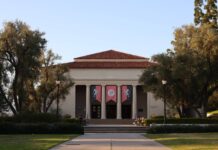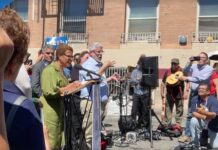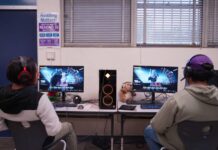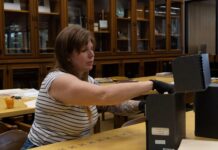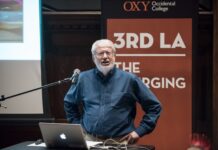Author: Chelsea Kellogg
North Adams, MA bore the unmistakable signs of withered industrial town.
In 1996, abandoned warehouses, empty lots and a silent clock tower prophesied the small town’s impending demise.
Christina Kubisch, a professor of experimental art and a musician, visited North Adams that year and was taken with the mute clock tower.
Kubisch believed that the silencing of the clock tower a decade earlier had ripped the heart out of the struggling town.
Clock towers beat out the rhythm of a community’s heartbeat, and this is certainly the case at Occidental College.
On Founders Day, Wednesday, April 12, President Jonathan Veitch introduced some of the new sounds composed to mark the crawl of time on campus.
Despite this announcement, however, most students did not become aware of the carillon’s changed sound until Monday, April 18, when the bells began their rotation.
Three Occidental music professors, Bruno Louchouarn, Andre Myers and Jennifer Logan composed the sounds for the project, which was proposed to them by President Veitch earlier this semester. For decades, the Occidental clock tower played the Westminster chimes, but President Veitch wanted a more distinctive sound.
“That tower marks the time we spend together. The unexpected nature of the tower should be a metaphor for the unexpected nature of Occidental College,” President Veitch said.
President Veitch’s inspiration for this performance art project stemmed from an experience he had at Massachusetts Museum of Contemporary Art in North Adams, MA.
“Long before I became president, I went to MASS MoCA. There they commissioned artists to make music for the tower. I found that whimsical and delightful,” President Veitch said.
For President Veitch, the inspiring “Clocktower Project” in North Adams and the success of Kubisch’s performance piece in integrating MASS MoCA into the town demonstrated an intriguing model of community interaction.
Each professor composed a composition of their own, with each piece featured two days of the week. On Friday, the three take turns, rotating every hour.
The bells begin at six in the morning — a jolting wake-up call, especially if the carillon malfunctions as it did on the morning of the first Tuesday rotation. The bell repeated a few seconds of Myers’ “Occidental Quarters” for 10 minutes until the issue could be rectified.
Professor Louchouarn composed what is arguably the most unfamiliar of the three bell sounds. Louchouarn recorded the voices of 12 people from the Occidental community. He then used the voice pattern of each person to shape the sound of the bell as the time strikes the hour mark.
“I wanted to make something that would actually bring the people into the sound,” Louchouarn said. “If you pay attention to the peal at the end of the melody ever hour, you can sort of hear the bells say ‘one, two’ and so forth.”
Myers’ composition, “The Occidental Quarters,” takes inspiration from traditional Westminster chimes and the American composer John Cage. It plays on Tuesdays and Saturdays.
“Meditation on Time and Timelessness” was composed by Professor Logan. Logan intended to experiment with layers of sound and tell multiple stories of time in her bell.
“It is gentle, dreamlike reminder of the moment in which we find ourselves, that we should do our best to embrace the beauty of each of these moments, as time is precious and fleeting.”
“The idea behind this Neverland is that we can embrace our inner youthfulness, enthusiasm, dreams and goals with a conscientious awareness that we are impermanent and should use our time thoughtfully,” she said.
There has been a strong negative reaction to the new bells, with over 500 people joining a Facebook petition against the bells within 24 hours of their inception.
Anti-bells group creator Anna Kurnizki (sophomore) said that the volume and strangeness of the sound were annoying to students, neighbors and prospective students.
On Facebook she wrote, “We prefer normal bell chimes to the loud, dissonant alien-abduction sounds.”
President Veitch countered on Thursday, April 21, personally authoring a post on the event wall.
He joked, “I myself was once abducted by aliens (though I don’t share that with many people). I can tell you that the chimes sounded nothing like this. I would like to take this opportunity to remind you all that alien abduction is a serious problem and is not to be joked about.”
On a more serious note, he suggested that an “alien ice cream truck party” on the Quad and a lecture from the three bell composers would be a good forum for better understanding the decision.
Both the composers and the President agree that surprise and strangeness were an integral part of the performance art concept.
“If I came to a campus and heard new and surprising and unusual sounds, I would think that in this place there are unexpected and unusual things happening,” Veitch said.
Many students agree that the bells are strange and unusual. “It’s the intensely loud static creepiness that bothers me, not the fact that it’s different from the old chimes,” Kurnizki said.
Haley Gray (first-year) echoed Kurnizki’s sentiment. “We are a college. Not a creepy ice cream truck,” Gray said.
Some students, however, have become ardent supporters of the new bells.
“They’re lovely. Why is everyone so opposed to change?” Maida Salkanovic (sophomore) said. “While we are complaining that they are annoying, some people hear grenades every 15 minutes. And that, trust me, is a lot more troublesome than the bells.”
According to Louchouarn, the intention of the switch was to remind our community of the role of the clock tower and induce people to contemplate their connection with the commonly ignored carillon.
If the now over 700 members of the Facebook petition indicate anything, it is that community already has an active relationship with the Occidental clock tower.
Affection for the old bells, technical malfunctions and a largely vituperative community reaction welcomed the Occidental carillon’s first foray into performance art.
President Veitch signaled willingness to include students in the next bell project, offering community involvement that could soften future complaints about the change.
But for students who cannot overcome their aversion to the new sounds, President Veitch assured a reprieve was in sight.
“These aren’t permanent. They will maybe last for four to six weeks or a month or two,” he said.
This article has been archived, for more requests please contact us via the support system.
![]()



